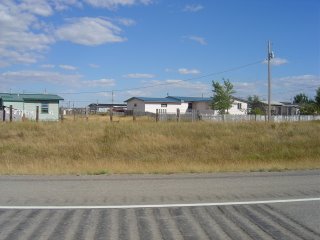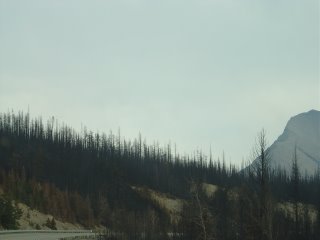Saturday, October 28, 2006
Going to Glacier
 It takes me a while to find Rosalyn again, since while I was at the museum she moved from the Cuts Wood School to what she refers to as the "World Headquarters" of the Piegan Institute. There's no particular reason it takes me a while to find her; the directions she gave me turn out to be flawless and the place is only about six blocks away. But I manage to get lost amid one street of crackerbox houses after another and have to ask for directions again, in a place that's almost directly across the street from my destination.
It takes me a while to find Rosalyn again, since while I was at the museum she moved from the Cuts Wood School to what she refers to as the "World Headquarters" of the Piegan Institute. There's no particular reason it takes me a while to find her; the directions she gave me turn out to be flawless and the place is only about six blocks away. But I manage to get lost amid one street of crackerbox houses after another and have to ask for directions again, in a place that's almost directly across the street from my destination.Rosalyn is sitting with Shirlee, whom I met at the school, and with the executive director of the Piegan Institute, Darrell Kipp. Darrell is a big man with graying hair pulled back in a ponytail, and he's sitting and talking while Shirlee does something that looks like actual work and Rosalyn listens. He asks about my trip across the High Line, what I've seen and done. I get into it a ways and soon we're swapping stories of the emptiness of the eastern Montana.
Darrell tells about a girl he once dated who was from Scobey, Montana. I passed a large billboard advertising Scobey on my way through, and although there were some plausibly interesting things mentioned on it I looked at the map and decided it was too far off the beaten track for even me on even this adventure, as if there's some other adventure I might take where Scobey would be a justifiable part of the itinerary. Darrell talks about driving out there and seeing a house out by itself, miles from anything else, and wondering what the man who lives in that house does with his day - does he get up, and go out and sit on his porch, and look at nothing until it's time for lunch?
It's more or less a thought that's occurred to me over and over again in the last week or so. If you're wondering how vast and empty that part of the world is, it's the part of the world that people in Browning, Montana, think is vast and empty.
Darrell is a raconteur with the best of them, and we pass a couple hours talking. Or "visiting," as Darrell likes to say - he tells of meeting someone: "so we visited for a while." It does occur to me that the others in the room, who may have heard some of these stories before, maybe more than once, might just as soon visit a little less this afternoon. But I'm pretty entranced.
Eventually we depart and I follow Rosalyn through town to her mom's house, which is in a newer subdivision at the north end of town. To the west are mountains and fire. It's been a heavy fire season this summer, and Rosalyn points to a new one with huge billows of smoke in the mountains of Glacier Park to the west.
Rosalyn and Angie and I visit for a while - local news that I know nothing about, the fires, family history. Angie shows me a picture of her grandparents in the living room, in full Indian costume - and costume is the right word. The picture is from a postcard printed by the Great Northern Railroad to drum up passenger business. One of the featured attractions was the opportunity to see real, live Indians at Glacier Park. So Angie's grandparents earned money by standing at the entrance to Glacier, dressed the part.
 Then, in the late afternoon, we get back into our cars and drive over the ridge to Glacier National Park, where I'm going to camp for the night. Near the top of the ridge the aftermath of the fires is on display. Whole hillsides are covered with charred spikes; in places the road itself is burnt black.
Then, in the late afternoon, we get back into our cars and drive over the ridge to Glacier National Park, where I'm going to camp for the night. Near the top of the ridge the aftermath of the fires is on display. Whole hillsides are covered with charred spikes; in places the road itself is burnt black. We head down the mountain to some property belonging to Rosalyn's uncle, on the shore of Lower St. Mary Lake, or possibly St. Mary's Lake, or if you prefer the Walled-In Lakes, or the Old Woman Lakes. It's beautiful and cold, which is partly due to latitude and partly due to its surprising depth. On its banks grow sarvis berries, which we've come to pick. In the driveway there's some evidence that bears have come to pick them recently, too. (Sarvis berries are like a less-sweet blueberry; Rosalyn tells me that Dave, who spent even more of his youth in the blueberry growing regions of Michigan than I did, isn't too fond of them. Good blueberries are, I must admit, superior, but I wouldn't dismiss sarvis berries out of hand. And today, they win by forfeit. The Canadians, incidentally, call them Saskatoons.)
 Here's a picture of Rosalyn picking berries. There would be a superior picture of Rosalyn and Angie together here, but your correspondent rushed the shot, and then didn't bother to look at it right away, and that's the way that goes.
Here's a picture of Rosalyn picking berries. There would be a superior picture of Rosalyn and Angie together here, but your correspondent rushed the shot, and then didn't bother to look at it right away, and that's the way that goes.It's starting to get dark - I'm suddenly in the mountains, and the dark comes on quickly - so we head back down the road to the campground at Glacier National Park. There are signs warning of bears in the area. I'm made to promnise to do a long list of things to keep bears away, like lock all my food in the car or a bear locker, and not have any perfumes and cosmetics in the car with me. They haven't been bothering campers, the friendly park ranger assures, me, adding, "and we want to keep it that way."
 I pick a site, frankly without working too hard, and it's not perfect, but it does provide a substantially different view than what I've been looking at in recent weeks. Angie and Rosalyn help me put up my tent. Angie doesn't seem too impressed by it; "That would never make it during Indian Days," she tells me. They give me a big bag of sarvis berries and leave me to face the grizzlies alone.
I pick a site, frankly without working too hard, and it's not perfect, but it does provide a substantially different view than what I've been looking at in recent weeks. Angie and Rosalyn help me put up my tent. Angie doesn't seem too impressed by it; "That would never make it during Indian Days," she tells me. They give me a big bag of sarvis berries and leave me to face the grizzlies alone.